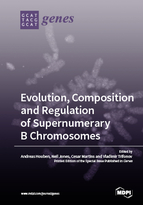Evolution, Composition and Regulation of Supernumerary B Chromosomes
A special issue of Genes (ISSN 2073-4425). This special issue belongs to the section "Population and Evolutionary Genetics and Genomics".
Deadline for manuscript submissions: closed (31 August 2018) | Viewed by 85163
Special Issue Editors
Interests: chromosome structure; B chromosome; centromere; CENH3; genome evolution
Interests: plant cytogenetics; B chromosomes; genome evolution
Interests: B chromosomes; genome evolution; evolution; comparative genomics
Interests: evolution of vertebrate genomes; sex determination and sex chromosomes; B chromosomes; comparative genomics
Special Issues, Collections and Topics in MDPI journals
Special Issue Information
Dear Colleagues,
Supernumerary B chromosomes are dispensable genetic elements found in thousands of species of plants and animals, and some fungi. Since their discovery, more than a century ago, they have been a source of puzzlement, as they only occur in some members of a population and are absent from others. When they do occur, they are often harmful, and in the absence of 'selfishness', based on mechanisms of mitotic and meiotic drive, there appears to be no obvious reasons for their existence. Cytogeneticists have long wrestled with questions about the biological existence of these enigmatic B chromosomes, including their lack of any adaptive properties, apparent absence of functional genes, their origin, sequence organization and co-evolution as nuclear parasites. Emerging new technologies are now enabling researchers to step up a gear, to look enthusiastically beyond the previous limits of the horizon, and to uncover the secrets of these 'silent' elements. Detailed investigations into their DNA composition, transcriptional activity and effects on the host transcriptome profile are beginning to uncover a wealth of new information. Contributing authors come from across a wide range of species, and different systems, and their thematic output will give a broad view and a significant step forward to understanding this perplexing biological story.
Prof. Andreas HoubenProf. Neil Jones
Prof. Cesar Martins
Dr. Vladimir Trifonov
Guest Editors
Manuscript Submission Information
Manuscripts should be submitted online at www.mdpi.com by registering and logging in to this website. Once you are registered, click here to go to the submission form. Manuscripts can be submitted until the deadline. All submissions that pass pre-check are peer-reviewed. Accepted papers will be published continuously in the journal (as soon as accepted) and will be listed together on the special issue website. Research articles, review articles as well as short communications are invited. For planned papers, a title and short abstract (about 100 words) can be sent to the Editorial Office for announcement on this website.
Submitted manuscripts should not have been published previously, nor be under consideration for publication elsewhere (except conference proceedings papers). All manuscripts are thoroughly refereed through a single-blind peer-review process. A guide for authors and other relevant information for submission of manuscripts is available on the Instructions for Authors page. Genes is an international peer-reviewed open access monthly journal published by MDPI.
Please visit the Instructions for Authors page before submitting a manuscript. The Article Processing Charge (APC) for publication in this open access journal is 2600 CHF (Swiss Francs). Submitted papers should be well formatted and use good English. Authors may use MDPI's English editing service prior to publication or during author revisions.
Keywords
- accessory chromosome
- B chromosome
- supernumerary chromosome
- selfish DNA
- degeneration
- chromosome drive
- gene silencing
- heterochromatization
- Muller’s ratchet
- mutation accumulation
- pseudogenization
- recombination
- repetitive DNA
- retrotransposons
- pseudogene
- evolution
- karyotype
- next generation sequencing
- chromosome thripsis










